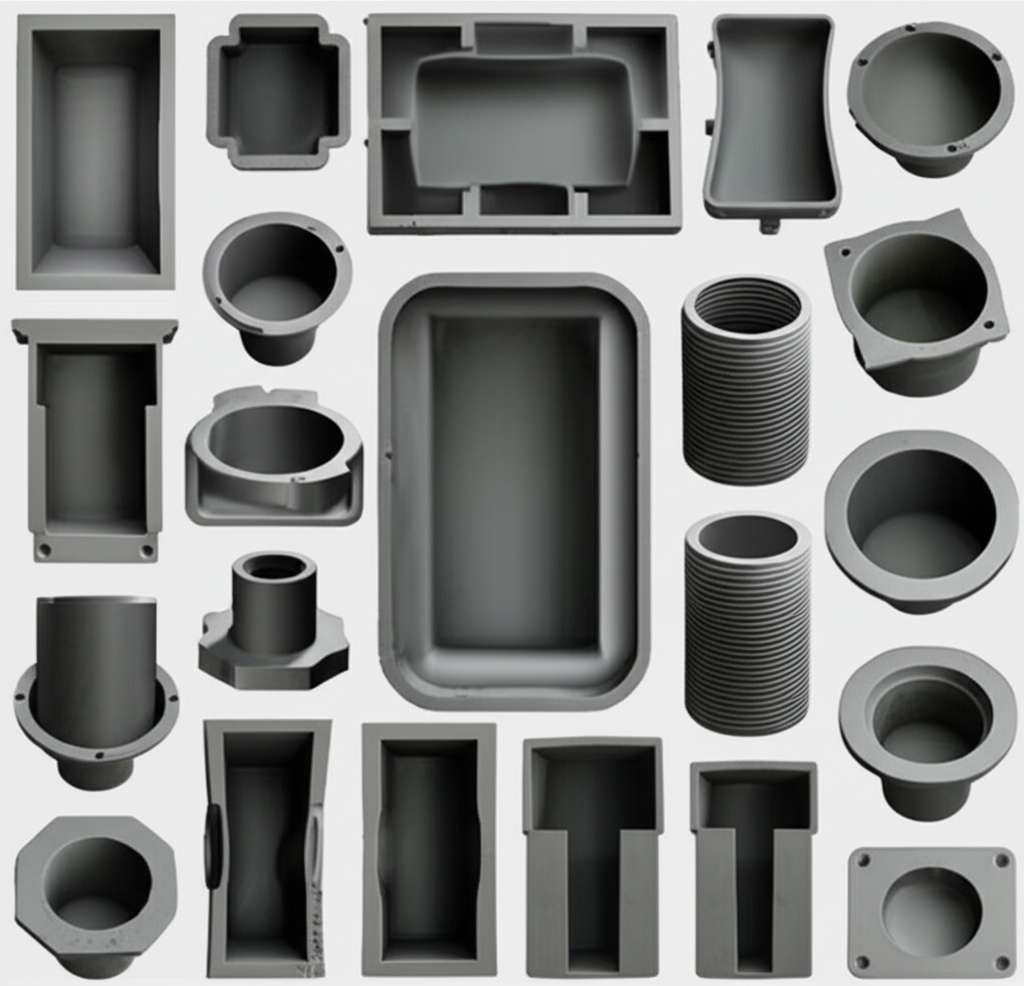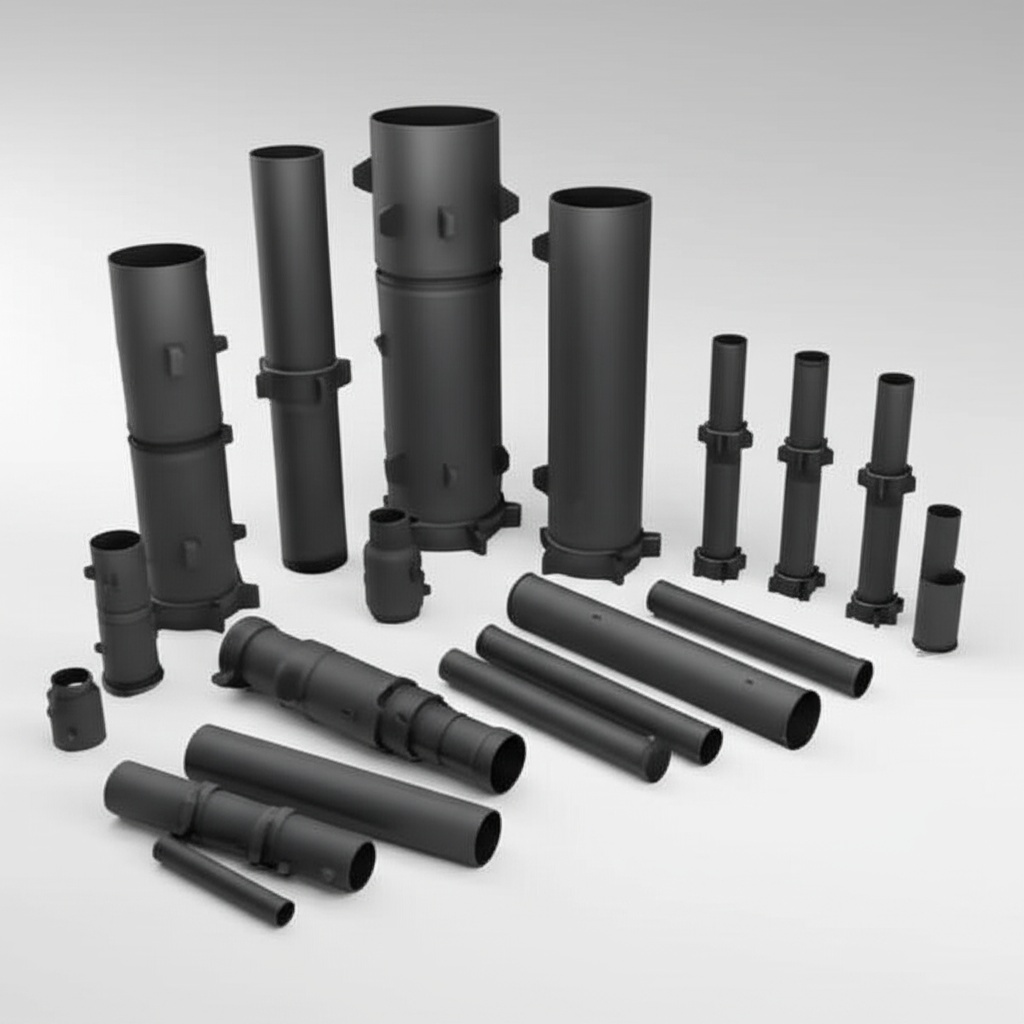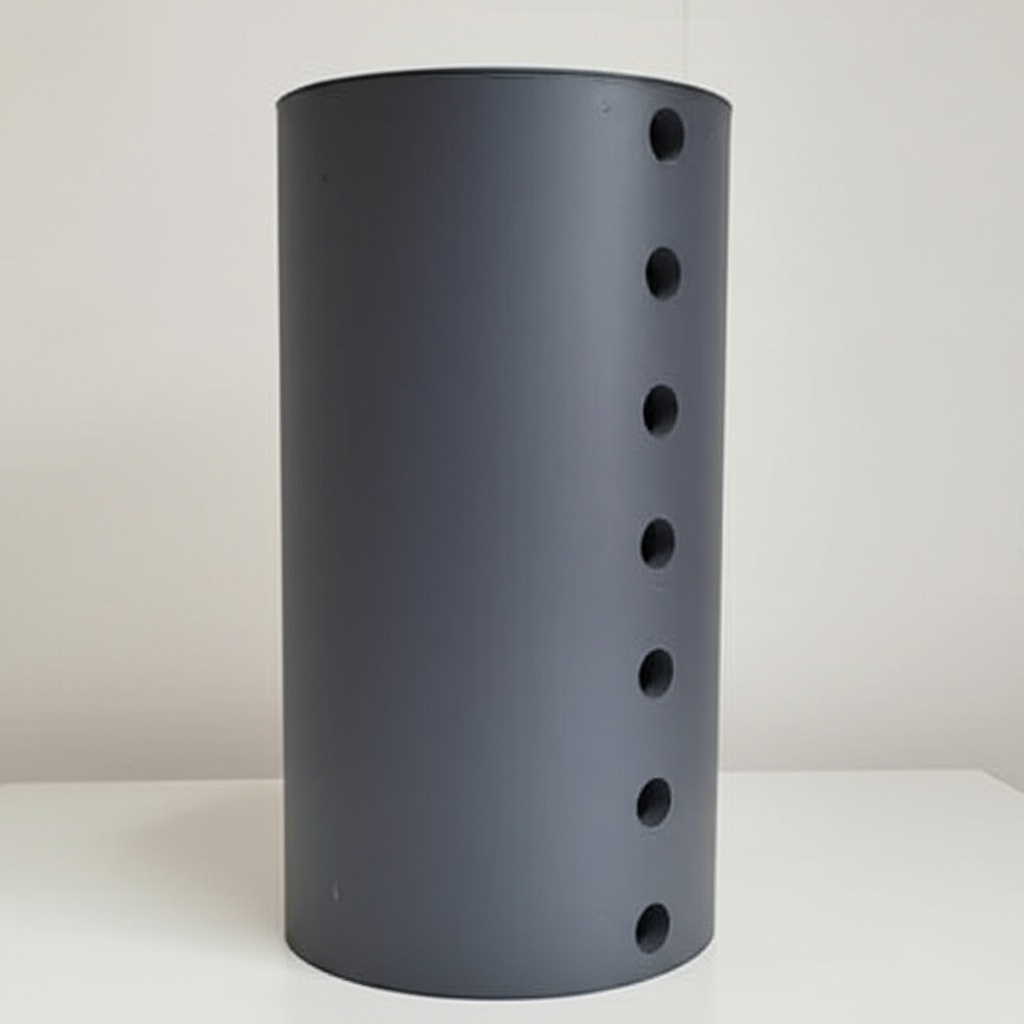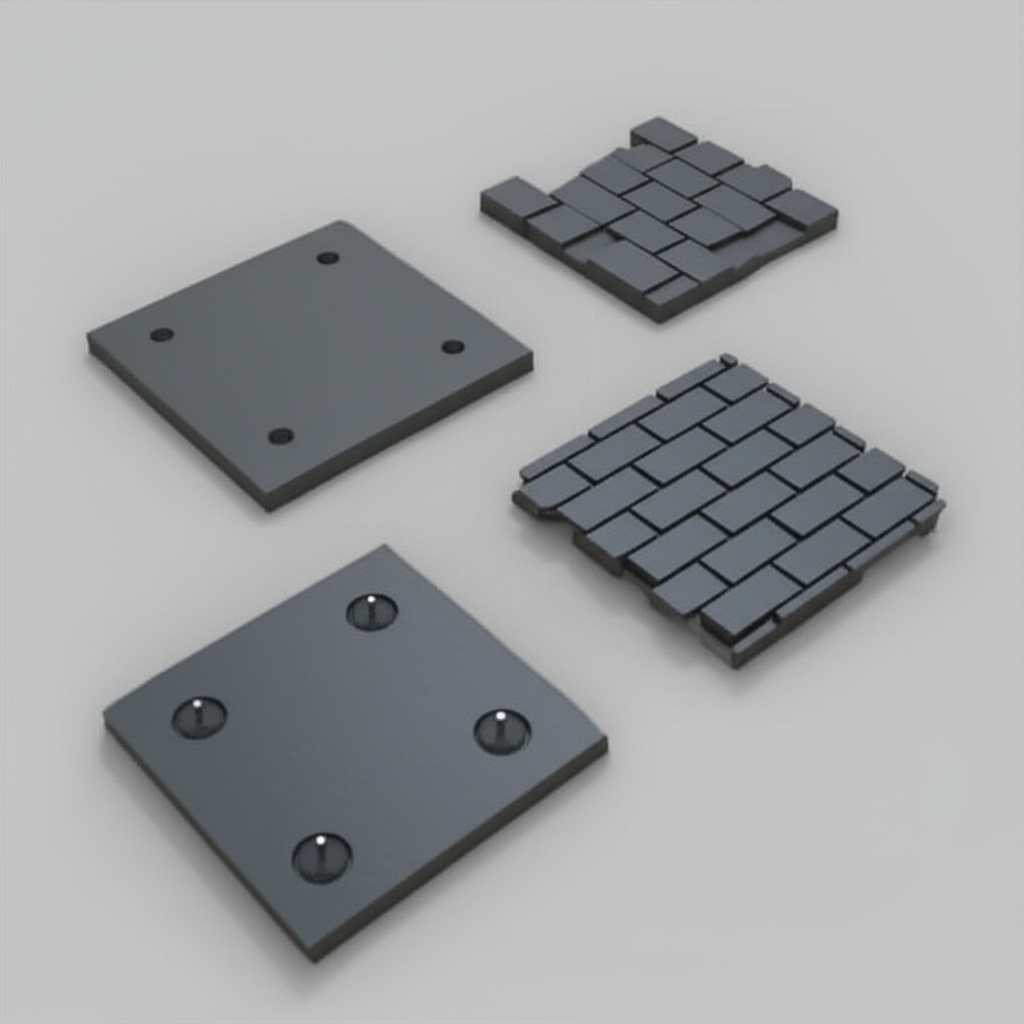SiC for More Robust Industrial Automation Systems

Share
SiC for More Robust Industrial Automation Systems
Introduction: The Unseen Backbone of Modern Automation – Custom Silicon Carbide
In the relentless pursuit of efficiency, precision, and reliability, modern industrial automation systems are pushing the boundaries of material science. While software and robotics often take the spotlight, the underlying materials used in critical components play an equally vital role. Among these advanced materials, custom silicon carbide (SiC) is emerging as an unsung hero, providing the unseen backbone for increasingly demanding applications. Industrial automation, spanning sectors from semiconductor manufacturing to aerospace and automotive, relies on components that can withstand extreme conditions, maintain dimensional stability, and offer extended operational lifetimes. Traditional materials like metals and conventional ceramics often fall short when faced with aggressive chemicals, high temperatures, abrasive wear, or the need for ultra-high purity. This is where the unique properties of silicon carbide shine, making it an essential element in high-performance industrial applications. Customization further amplifies these benefits, allowing engineers to design SiC components tailored to the specific challenges of their automation processes, leading to enhanced productivity, reduced downtime, and superior end-product quality. As automation continues to evolve, incorporating more sophisticated processes and operating in harsher environments, the demand for robust and reliable materials like custom SiC will only intensify, making it a cornerstone of next-generation industrial machinery.
Why Silicon Carbide Excels in Demanding Industrial Automation Environments
Silicon Carbide (SiC) possesses an exceptional combination of physical and chemical properties that make it uniquely suited for the rigorous demands of industrial automation environments. Unlike many conventional materials, SiC maintains its structural integrity and performance characteristics under conditions that would cause others to fail. Its suitability stems from several key attributes:
- Exceptional Hardness and Wear Resistance: SiC is one ofikahe hardest commercially available ceramic materials, second only to diamond. This translates to outstanding resistance to abrasion, erosion, and sliding wear. In automation systems, components like guide rails, bearings, nozzles, and end-effectors made from SiC can endure millions of cycles with minimal material loss, ensuring consistent precision and significantly extending maintenance intervals.
- High-Temperature Stability: Industrial automation often involves processes operating at elevated temperatures, such as in foundries, heat treatment, or semiconductor fabrication. SiC exhibits excellent thermal stability, retaining its strength and mechanical properties at temperatures exceeding 1400°C (and even higher for certain grades). It also has a low coefficient of thermal expansion, minimizing dimensional changes during temperature fluctuations, which is critical for precision machinery.
- Superior Thermal Conductivity: Despite being a ceramic, many grades of SiC offer high thermal conductivity. This property is crucial for dissipating heat rapidly from critical areas in automated equipment, such as in power electronics modules, high-frequency spindles, or plasma etch components. Efficient heat management prevents overheating, improves component lifespan, and maintains system stability.
- Chemical Inertness and Corrosion Resistance: Automated systems in chemical processing, semiconductor manufacturing, and other industries often handle corrosive substances. SiC is highly resistant to a wide range of acids, alkalis, and molten salts, even at high temperatures. This chemical inertness prevents contamination and component degradation, ensuring process purity and equipment longevity.
- High Stiffness and Low Density: SiC boasts a high Young’s modulus, meaning it is very stiff and resists deformation under load. Coupled with its relatively low density (compared to many metals with similar stiffness), this results in components with high specific stiffness. This is particularly advantageous for high-speed robotic arms and moving parts in automated machinery, where low inertia and high rigidity are essential for rapid, precise movements.
- Electrical Properties: While often used as an insulator, SiC is a semiconductor. This allows for its use in specialized applications within automation, such as high-power, high-frequency electronic devices that can operate in harsh environments. Doped SiC can also be tailored for specific electrical conductivity requirements, offering versatility in component design.
These combined properties mean that SiC components contribute directly to more robust, reliable, and efficient automation systems, capable of operating for longer periods with greater precision and in more challenging conditions than ever before.
Customization is Key: Tailoring SiC for Peak Automation Performance
While the inherent properties of silicon carbide are impressive, the ability to create custom SiC parts truly unlocks its potential for peak performance in industrial automation. Off-the-shelf components may offer some advantages, but application-specific designs tailored to the unique operational stresses and geometric constraints of a particular automation system can yield transformative improvements. Customization allows engineers and designers to move beyond simply replacing a problematic metal or ceramic part with SiC, and instead, to re-engineer the component or even the sub-assembly to fully leverage SiC’s strengths.
The benefits of custom SiC in automation include:
- Optimized Geometry for Function and Durability: Automation systems often involve complex movements and interactions. Custom SiC components can be designed with specific shapes, contours, and features that enhance their functional performance – for example, an end-effector shaped for a delicate wafer handling task or a nozzle designed for precise fluid dispensing. Geometry can also be optimized to minimize stress concentrations and improve resistance to mechanical shock or vibration, common challenges in dynamic automated environments.
- Integration with Existing Systems: Customization facilitates seamless integration of SiC parts into existing machinery. Mounting points, interfaces, and overall dimensions can be precisely matched, reducing the need for costly modifications to surrounding equipment. This is crucial for upgrades and retrofitting projects where compatibility is paramount.
- Application-Specific Material Grade Selection: Not all SiC is the same. Different manufacturing processes (e.g., reaction-bonded, sintered, CVD) result in SiC materials with varying densities, porosities, and secondary phases, leading to different performance characteristics. Customization allows for the selection of the most appropriate SiC grade whose properties (e.g., maximum operating temperature, thermal conductivity, electrical resistivity) are perfectly aligned with the application’s demands.
- Enhanced Efficiency and Throughput: By designing SiC components that are lighter, stiffer, more wear-resistant, or capable of operating at higher temperatures, automation systems can often achieve faster cycle times, higher precision, and increased throughput. For instance, a lighter, stiffer SiC robotic arm allows for quicker acceleration and deceleration with less vibration.
- Reduced Downtime and Maintenance Costs: Custom SiC components designed for longevity in specific harsh conditions significantly reduce the frequency of part replacements and maintenance interventions. This leads to improved Overall Equipment Effectiveness (OEE) and lower total cost of ownership. For OEM SiC solutions, this translates to a more reliable and marketable end-product.
- Prototyping and Iterative Design: Reputable SiC suppliers offering customization can work closely with clients through prototyping and iterative design phases. This collaborative approach ensures that the final SiC component is perfectly optimized for its intended function within the automation system, addressing unforeseen challenges early in the development cycle.
In essence, tailoring silicon carbide parts transforms a high-performance material into a strategic engineering solution, enabling automation systems to operate at levels of efficiency, reliability, and precision previously unattainable with standard materials or off-the-shelf components. This tailored approach is fundamental to achieving a competitive edge in today’s advanced manufacturing landscape.
Selecting Optimal SiC Grades for Industrial Automation Components
Choosing the correct grade of silicon carbide is a critical decision that directly impacts the performance, longevity, and cost-effectiveness of components within industrial automation systems. Different manufacturing processes yield SiC materials with distinct microstructures and property profiles. Understanding these differences is key to matching the material to the specific demands of an automation application. Here are some commonly used SiC grades and their relevance to automation parts:
| SiC Grade | Key Characteristics | Typical Automation Applications | Considerations |
|---|---|---|---|
| Reaction-Bonded Silicon Carbide (RBSiC / SiSiC) | Good mechanical strength, excellent wear and corrosion resistance, relatively complex shapes possible, moderate cost. Contains some free silicon (typically 8-15%). | Wear liners, nozzles, pump components (shafts, sleeves, impellers), mechanical seals, kiln furniture, precision components for handling systems. | Presence of free silicon limits maximum operating temperature (around 1350°C) and can be reactive in certain aggressive chemical environments. |
| Sintered Silicon Carbide (SSiC) | Very high purity (typically >98% SiC), excellent high-temperature strength, superior corrosion and wear resistance, good thermal shock resistance. No free silicon. | Bearings, bushings, mechanical seal faces, semiconductor processing equipment parts (etch rings, chucks), valve components, heat exchanger tubes, components for high-purity chemical handling. | Typically more expensive than RBSiC. Machining can be more challenging due to its extreme hardness. Shape complexity can be more limited compared to RBSiC. |
| Nitride-Bonded Silicon Carbide (NBSiC) | Good thermal shock resistance, high strength, good wear resistance, resistant to molten metals. Formed by SiC grains bonded by silicon nitride. | Foundry components (e.g., thermocouple protection tubes, crucibles), kiln furniture, components in non-ferrous metal handling, burner nozzles. | May have lower overall corrosion resistance in certain environments compared to SSiC. Properties can vary based on the specific bonding phase. |
| Chemical Vapor Deposited (CVD) SiC | Ultra-high purity (99.999%+), excellent surface finish, can form coatings or monolithic parts, superior chemical resistance. | Semiconductor wafer processing components (susceptors, gas showerheads, dummy wafers), high-purity optical components, protective coatings on graphite or other SiC grades. | Highest cost among SiC grades. Typically used for applications where extreme purity or specific surface properties are paramount. Limited to thinner sections or coatings for some applications. |
| Recrystallized Silicon Carbide (RSiC) | High porosity, excellent thermal shock resistance, good high-temperature strength. Made by firing SiC powder at very high temperatures. | Kiln furniture (beams, posts, plates), burner components, setters for high-temperature firing processes. | Higher porosity means lower mechanical strength and wear resistance compared to dense SiC grades like SSiC or RBSiC. Not suitable for applications requiring hermetic sealing or high wear resistance. |
The material selection process for automation parts should involve a thorough analysis of the operating environment, including temperature, chemical exposure, mechanical loads, wear mechanisms, and any electrical or thermal conductivity requirements. Consulting with an experienced SiC supplier who understands these nuances is crucial. They can provide guidance on the most suitable grade and even discuss options for composite materials or surface modifications if the application demands a unique combination of properties not found in a single standard grade. This ensures that the chosen SiC component delivers optimal performance and reliability within the specific automation context.
Critical Design Considerations for SiC Components in Automated Systems
Designing components with silicon carbide for automated systems requires a different mindset than working with traditional metals or plastics. SiC’s inherent brittleness, while offset by its incredible hardness and stiffness, means that careful attention must be paid to design details to ensure manufacturability, structural integrity, and optimal performance. Effective SiC design engineering focuses on leveraging its strengths while mitigating its limitations.
Key design considerations include:
- Managing Brittleness:
- Avoid Sharp Corners and Edges: Sharp internal corners act as stress concentrators. Generous radii and chamfers should be incorporated to distribute stress and reduce the risk of chipping or fracture. External edges should also be chamfered or rounded.
- Minimize Tensile Stresses: SiC is significantly stronger in compression than in tension. Designs should aim to keep SiC components under compressive loads where possible. Analyze stress distributions carefully using Finite Element Analysis (FEA).
- Impact Resistance: Design to protect SiC parts from direct impacts. Consider incorporating compliant materials or shock-absorbing features in the assembly if impacts are unavoidable.
- Geometry and Manufacturability:
- Simplicity: While complex shapes are possible, especially with RBSiC, simpler geometries are generally easier and less costly to manufacture. Complex features increase machining time and cost.
- Wall Thickness: Maintain uniform wall thicknesses where possible to avoid stress during sintering (for SSiC) or reaction bonding. Avoid overly thin sections unless structurally justified and manufacturable. Minimum wall thickness depends on the SiC grade and manufacturing process.
- Aspect Ratios: Very high aspect ratios (e.g., long, thin rods or wide, thin plates) can be challenging to manufacture and handle without breakage.
- Holes and Features: The size, spacing, and location of holes and other features need careful consideration. Holes too close to edges or each other can create weak points.
- Joining and Assembly:
- Avoid Direct Threading: Directly threading SiC is generally not recommended due to its brittleness. Instead, use metallic inserts, brazing, shrink-fitting, or clamping mechanisms.
- Differential Thermal Expansion: When joining SiC to other materials (especially metals), carefully consider the differences in coefficients of thermal expansion (CTE). Compliant interlayers or specific joint designs may be needed to accommodate CTE mismatches and prevent stress buildup during thermal cycling.
- Tolerances and Surface Finish:
- Realistic Tolerances: Extremely tight tolerances increase manufacturing costs significantly. Specify tolerances that are truly necessary for the function of the component.
- Surface Finish Requirements: The required surface finish depends on the application (e.g., sealing surfaces, wear surfaces, optical components). Smoother finishes require more extensive grinding and lapping, adding to the cost.
- Load Distribution:
- Ensure that loads are distributed as evenly as possible across SiC components. Point loads can lead to high localized stresses and potential failure. Use compliant gaskets or pads if necessary.
- Cost Implications:
- Design choices directly impact cost. Complex geometries, tight tolerances, fine surface finishes, and extensive machining will increase the price of the SiC component. Optimize the design for functionality while being mindful of manufacturing costs.
Effective design for SiC components in precision automation, such as robotic components or sensor housings, often involves close collaboration between the end-user’s engineering team and the SiC manufacturer. This ensures that the design is not only theoretically sound but also practically manufacturable and cost-effective. Early consultation can prevent costly redesigns and lead to more robust and reliable automation solutions.
Achieving Precision: Tolerances, Surface Finish, and Dimensional Accuracy with SiC
In the realm of industrial automation, precision is often non-negotiable. The accuracy of robotic movements, the reliability of sensor readings, and the efficiency of material handling systems all depend on components manufactured to exacting specifications. Silicon carbide, despite its extreme hardness, can be processed to achieve very tight tolerances, fine surface finishing, and excellent dimensional stability, making it suitable for the most demanding automation applications.
Achieving this level of precision with SiC involves several stages and considerations:
- As-Fired vs. Machined Tolerances:
- As-Fired/As-Sintered: When SiC parts are initially formed (e.g., through pressing, slip casting, or injection molding) and then fired or sintered, they will have certain inherent dimensional tolerances. These “as-fired” tolerances are typically wider, often in the range of ±0.5% to ±2% of the dimension, depending on the SiC grade, size, and complexity of the part. For some non-critical automation applications, as-fired tolerances may be acceptable.
- Machined Tolerances: For applications requiring higher precision, post-sintering machining (grinding, lapping, polishing) is necessary. Using diamond tooling, SiC can be machined to achieve very tight tolerances, often down to micrometers (e.g., ±0.005 mm or better for critical features). This precision SiC machining is a specialized process.
- Surface Finish Capabilities:
- The surface finish of a SiC component is crucial for its performance in many automation tasks. For example, mechanical seals require highly polished surfaces (Ra < 0.2 µm) to ensure proper sealing and minimize friction. Bearings and wear components also benefit from smooth surfaces to reduce wear rates.
- Achievable surface finishes range from a relatively rough as-fired surface to highly polished, mirror-like finishes obtained through lapping and polishing with progressively finer diamond abrasives. Standard ground finishes are typically in the Ra 0.4 to 0.8 µm range, while lapped and polished surfaces can achieve Ra < 0.05 µm.
- Dimensional Stability:
- One of SiC’s key advantages is its excellent dimensional stability over a wide range of temperatures due to its low coefficient of thermal expansion and high stiffness. Once manufactured to specification, SiC components maintain their dimensions and shape, ensuring consistent automation accuracy even under fluctuating thermal conditions or high mechanical loads. This is critical for components like metrology stages, optical benches, or precision guides in automated inspection systems.
- Factors Influencing Achievable Precision:
- SiC Grade: The specific grade of SiC can influence machinability and the ultimate precision achievable. Finer-grained SSiC, for example, can often be machined to tighter tolerances and finer finishes than coarser-grained RBSiC.
- Part Geometry: Complex geometries with internal features or difficult-to-access surfaces can be more challenging to machine to tight tolerances.
- Machining Expertise and Equipment: Achieving high precision in SiC requires specialized diamond grinding equipment, experienced machinists, and robust metrology capabilities.
- Cost: It’s important to recognize that tighter tolerances and finer surface finishes invariably lead to increased manufacturing time and cost. Therefore, specifications should be no more stringent than functionally required.
When specifying tolerances and surface finishes for SiC components in automation, engineers should clearly communicate the functional requirements of the part. Working closely with a knowledgeable SiC supplier during the design phase can help establish realistic and achievable specifications that balance performance needs with manufacturing costs, ensuring the final component contributes effectively to the overall precision of the automated system.
Enhancing Durability: Post-Processing Techniques for SiC Automation Parts
While silicon carbide is inherently durable, certain post-processing techniques can further enhance its performance, longevity, and suitability for specific demanding applications within industrial automation. These treatments are designed to improve surface characteristics, seal porosity, or add functional layers, ultimately optimizing the component longevity and reliability of wear parts and other critical elements.
Common post-processing techniques for SiC automation components include:
- Grinding and Lapping:
- Purpose: To achieve precise dimensional tolerances and specific surface finishes. Grinding uses diamond wheels to remove material and shape the part accurately. Lapping employs fine abrasive slurries and a lapping plate to produce very flat, smooth surfaces with tight parallelism.
- Benefit in Automation: Essential for components requiring high precision, such as bearings, seal faces, guide rails, and metrology components. Smooth, accurately dimensioned surfaces reduce friction, wear, and improve sealing efficiency.
- Polishing:
- Purpose: A further refinement of lapping, used to achieve extremely smooth, often mirror-like surfaces (low Ra values).
- Benefit in Automation: Critical for optical applications (though less common in typical industrial automation), and for ultra-high-purity applications where minimizing particle generation from surfaces is key, such as in semiconductor handling equipment. Also beneficial for reducing stiction in dynamic seals.
- Edge Honing/Chamfering:
- Purpose: To remove sharp edges and corners, creating a small radius or chamfer.
- Benefit in Automation: Significantly reduces the risk of chipping or cracking at edges, which are often susceptible to damage in brittle materials like SiC. This improves the robustness of components during handling, assembly, and operation.
- Sealing (for porous grades):
- Purpose: Some SiC grades, like certain types of RBSiC or RSiC, may have residual porosity. Sealing involves impregnating the surface pores with materials like glass, resin, or even CVD SiC.
- Benefit in Automation: Improves chemical resistance by preventing ingress of corrosive media, enhances gas tightness for vacuum or pressure applications, and can increase strength by reducing internal stress concentrators.
- Coatings (e.g., CVD SiC, Diamond-Like Carbon – DLC):
- Purpose: Applying a thin layer of another material onto the SiC substrate to impart specific surface properties. For example, a CVD SiC coating can be applied to RBSiC to enhance its purity and chemical resistance, or a DLC coating can be applied to further reduce friction and wear.
- Benefit in Automation: A SiC coating can provide a cost-effective way to achieve ultra-high purity surfaces needed in semiconductor processing or enhance tribological performance for demanding wear applications without needing to make the entire component from a more expensive material.
- Cleaning and Passivation:
- Purpose: Specialized cleaning processes to remove any contaminants from manufacturing or handling, ensuring the component meets stringent cleanliness requirements, particularly for semiconductor, medical, or food processing automation. Passivation can sometimes be used to enhance the natural protective oxide layer on SiC.
- Benefit in Automation: Ensures process integrity and prevents contamination of sensitive products or processes.
The selection of appropriate post-processing steps depends heavily on the specific SiC grade, the component’s geometry, and its intended function within the automation system. For example, a simple structural support might only require basic grinding and edge chamfering, whereas a dynamic seal face will necessitate lapping and polishing to a very fine finish. Collaborating with a SiC manufacturer with comprehensive post-processing capabilities ensures that components are delivered fit-for-purpose, ready to provide optimal performance and durability in their designated automation role.
Navigating Challenges: Material Brittleness and Machining Complexities of SiC in Automation
Despite its many advantages, incorporating silicon carbide into industrial automation systems is not without its challenges. The two most significant hurdles are often SiC’s inherent brittleness and the complexities associated with its machining. Understanding these SiC material challenges and adopting strategies for design mitigation and advanced machining are crucial for successful implementation.
Addressing Material Brittleness:
Silicon carbide, like most advanced ceramics, exhibits brittle fracture behavior. This means it does not deform plastically like metals before fracturing; instead, it fails suddenly when its fracture toughness is exceeded. This characteristic requires careful consideration in design and handling:
- Design Strategies:
- Stress Management: Employ generous radii on all internal and external corners to reduce stress concentrations. Finite Element Analysis (FEA) is invaluable for identifying high-stress regions and optimizing the design to minimize tensile stresses.
- Compressive Loading: Design components so that SiC parts are primarily under compressive loads, where they are strongest.
- Impact Protection: Shield SiC components from direct impacts. If impacts are possible, consider incorporating compliant materials (e.g., elastomers) in the assembly to absorb shock.
- Support and Mounting: Ensure even load distribution at mounting points. Avoid point loads or overtightening clamps, which can induce localized stresses.
- Handling and Assembly:
- Train personnel on proper handling procedures for brittle materials. Avoid dropping or knocking SiC parts.
- Use appropriate tools and fixtures during assembly to prevent accidental damage.
- Material Selection:
- Certain SiC grades (e.g., toughened SiC composites, though less common) or SiC with specific microstructures might offer slightly improved fracture toughness. However, the primary mitigation strategy remains sound design.
- Thermal Shock Resistance: While many SiC grades have good thermal shock resistance due to high thermal conductivity and low thermal expansion, extreme and rapid temperature changes can still induce fracture. Analyze thermal gradients and cycling in the application and select grades (like SSiC or NBSiC) known for good thermal shock performance if this is a major concern.
Overcoming Machining Complexities:
The extreme hardness of silicon carbide makes it very difficult and time-consuming to machine. Conventional machining tools are ineffective; specialized diamond tooling and techniques are required.
- Machining Processes:
- Grinding: The primary method for shaping and dimensioning SiC parts after sintering or forming. Requires diamond grinding wheels and carefully controlled conditions.
- Lapping and Polishing: Used to achieve very fine surface finishes and tight flatness/parallelism to

About the Author: Sicarb Tech
We provide clear and reliable insights into silicon carbide materials, component manufacturing, application technologies, and global market trends. Our content reflects industry expertise, practical experience, and a commitment to helping readers understand the evolving SiC landscape.




